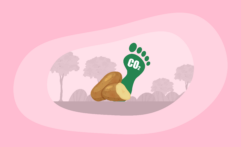The Environmental Impact of Peaches: From Farm to Table
Impactful Ninja is reader-supported. When you buy through links on our site, we may earn an affiliate commission.
Learn more
Learn more
.
Hey fellow impactful ninja ? You may have noticed that Impactful Ninja is all about providing helpful information to make a positive impact on the world and society. And that we love to link back to where we found all the information for each of our posts. Most of these links are informational-based for you to check out their primary sources with one click. But some of these links are so-called "affiliate links" to products that we recommend. First and foremost, because we believe that they add value to you. For example, when we wrote a post about the environmental impact of long showers, we came across an EPA recommendation to use WaterSense showerheads. So we linked to where you can find them. Or, for many of our posts, we also link to our favorite books on that topic so that you can get a much more holistic overview than one single blog post could provide. And when there is an affiliate program for these products, we sign up for it. For example, as Amazon Associates, we earn from qualifying purchases. First, and most importantly, we still only recommend products that we believe add value for you. When you buy something through one of our affiliate links, we may earn a small commission - but at no additional costs to you. And when you buy something through a link that is not an affiliate link, we won’t receive any commission but we’ll still be happy to have helped you. When we find products that we believe add value to you and the seller has an affiliate program, we sign up for it. When you buy something through one of our affiliate links, we may earn a small commission (at no extra costs to you). And at this point in time, all money is reinvested in sharing the most helpful content with you. This includes all operating costs for running this site and the content creation itself. You may have noticed by the way Impactful Ninja is operated that money is not the driving factor behind it. It is a passion project of mine and I love to share helpful information with you to make a positive impact on the world and society. However, it's a project in that I invest a lot of time and also quite some money. Eventually, my dream is to one day turn this passion project into my full-time job and provide even more helpful information. But that's still a long time to go. Stay impactful,Affiliate Disclosure
Why do we add these product links?
What do these affiliate links mean for you?
What do these affiliate links mean for us?
What does this mean for me personally?
![]()
Around 625.7 thousand tons of peaches are produced in the US every year. Whether you enjoy some juicy peaches during August (National Peach Month!) or appreciate them as an excellent source of vitamins A and C, they’re a classic fruit. But peaches can also cause some serious damage to the environment. So, we had to ask: What is the environmental impact of peaches?
Peaches have a minimally negative impact on the environment. This is mainly because they use monoculture farming and have high rates of pesticides and nitrogen fertilizers. However, they also rarely use plastic packaging and have a very low carbon footprint.
In this article, we will examine the environmental impact of peaches from several different angles. We will go through the life-cycle of peaches, detailing their impact on the environment from growth to distribution to your plate to waste management. We will then compare the environmental impact of peaches to that of other fruits. And, finally, we’ll share some tips with you on how you can reduce your own environmental impact and offset your own carbon emissions—both for your personal life and peach-related.
Here’s How We Assessed the Environmental Impact of Peaches
The Environmental Impact Assessment (EIA) is one of the ways we measure the potential environmental effects of our actions, like the consumption of peaches. It is a holistic assessment based on the environmental changes associated with our consumption. Those are changes in our environment that can have adverse effects on the air, land, water, fish, and wildlife or the inhabitants of the ecosystem.
“Environmental Impact: the effect that the activities of people and businesses have on the environment”
Cambridge Dictionary
Basically, all goods and services you buy—including peaches—leave an impact on our environment. When it comes to food in general, and peaches in specific, the following are key factors:
- Land requirements: Large parts of the world that were once covered by forests and wildlands are now used for agriculture. 10 million hectares of forest are destroyed annually and 50% of the world’s habitable land is now used for agriculture. This loss of natural habitat has been the main driver for reducing the world’s biodiversity.
- Water footprint: 70% of global freshwater is now used for agricultural purposes. By assessing the water footprint of a particular food, we can determine how our limited freshwater resources are being consumed and polluted.
- Pesticide and fertilizer usage: Pesticides and fertilizers provide a range of agricultural benefits. However, numerous studies link pesticides and fertilizers to serious effects on human health, along with disruptions to vital ecosystems and the spread of aquatic dead zones.
- Carbon footprint: The carbon footprint is one of the ways we measure the effects of our human-induced global climate change. Today, food production accounts for over a quarter (26%) of global greenhouse gas emissions.
- Waste generation: Food and its packaging account for almost 45% of the materials landfilled in the US alone. And packaging sent to landfills, especially when made from plastics, does not degrade quickly or, in some cases, at all.
To understand the overall environmental impact of peaches, we must assess each of their key factors. This Environmental Impact Assessment (EIA) is a tool originally developed to identify the environmental impacts of a project prior to decision-making and also helps us to evaluate the environmental impacts of peaches, from farm to table.
Here’s the Overall Environmental Impact of Peaches
The overall environmental impact of peaches is minimally negative. The main factors that are damaging to the environment are their use of monoculture agriculture, pesticides, and nitrogen fertilizer.
That being said, peaches have a lot of good qualities when it comes to environmental impact. They have very efficient land usage, a small carbon footprint, and don’t use plastic packaging. However, there are still a few things you should be wary of that might be damaging to the environment.
So, let’s have a look at the environmental impact of each key factor of peaches!
| Key Assessment Factors | Environmental Impact |
| Land requirements for peaches | Peaches’ land requirements are fairly low. However, they are grown in monocultures, which means that their environmental impact is slightly negative at this stage. |
| Water footprint of peaches | Peaches have a low water footprint of 36 inches of rain per year. Because of where they grow, they also don’t need irrigation, which keeps their water footprint minimal. |
| Agrochemical usage for peaches | Peaches’ agrochemical usage is very high. This is because they use above-average amounts of pesticides and nitrogen fertilizer, which is particularly harmful. |
| Carbon footprint of peaches | The carbon footprint of peaches is 0.17kg (0.38lbs) CO2e per pound of peaches. This is mainly due to their transportation and waste management. The vast distances required to get peaches into American grocery stores drive their carbon footprint up considerably. |
| Waste generation of peaches | Peaches’ waste generation is fairly low. This is mainly because they use cardboard instead of plastic packaging, which is more recyclable. However, their composting rates are still low. |
These are the overall summaries, but there is a lot more to the story. In the next few sections, we will dive deeper into each stage to illustrate to you all the important aspects of peaches’ environmental impact.
What Are the Land Requirements for Peaches
Peaches’ land requirements are fairly low. However, they are grown in monocultures, which means that their environmental impact is slightly negative at this stage.
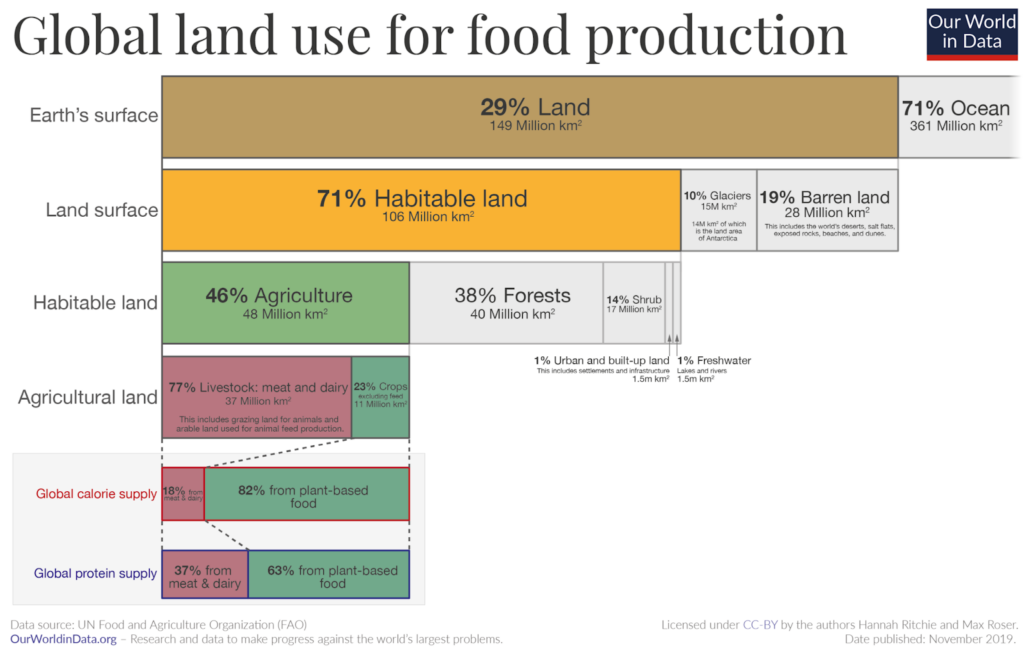
Growing peaches has a lot of variables that contribute to their environmental impact. The amount of land they use, the way in which they grow, and the amount of time they take to grow will all contribute to their environmental impact.
How do the land requirements of peaches impact their environmental footprint?
- What is the land usage of peaches: Peaches yield around 25–40 tons per hectare. This is an average to above-average yield for fruit, which means that their environmental impact is minimal at this stage.
- Where and how are peaches grown: Most of the world’s peaches are grown in China. Peaches grow on trees in orchards. Peach trees are very effective at carbon sequestration, which is the process of capturing carbon from the atmosphere and storing it in the ground. This lowers peaches’ carbon footprint and thus their environmental impact.
- Are peaches grown in monocultures or polycultures: Peaches are typically grown in monocultures. Monocultures are not only less productive agriculturally, leading to lower yields per hectare, but also very damaging to the environment. As a result, peaches’ growing method contributes very negatively to their environmental impact.
- How does the growing of peaches affect soil fertility and erosion: Peach farms have been found to contribute significantly to soil erosion. Soil erosion can severely damage the lands that they are farmed on, and thus pears have a highly negative environmental impact at this stage.
- How does the peach industry affect the loss of habitable land: China produces around 16 million tons of peaches, which translates to about 400,000 hectares of land. This is a significant amount of land in China and so peach production can have a negative effect on land usage.
- How does the peach industry affect wildlife and biodiversity: Monocultures are very damaging to biodiversity. They limit the growth of many important soil microbes and deplete pollinators of the diverse nutrients they need to thrive. This disrupts the whole ecosystem and thus pears cause a lot of environmental harm. Since peach farms use monocultures, they can have a very damaging impact on wildlife and biodiversity.
In short, peaches’ use of monoculture farming means they have a minimally negative environmental impact at this stage.
What Is the Water Footprint of Peaches
Peaches have a low water footprint of 36 inches of rain per year. Because of where they grow, they also don’t need irrigation, which keeps their water footprint minimal.
Water usage is one of the most important factors in the environmental impact of a fruit. The amount of water used, as well as the way they affect the water sources around them, are all major contributing factors. Here, we will look at these different angles of peaches’ water impact.
How does the water footprint of peaches impact their environmental footprint?
- What is the overall water usage of peaches: Peaches need about 36 inches of rain per year. This is a very low water requirement. For example, pears need around 50 inches per year, and watermelons up to 100. This means that water usage contributes very minimally to their environmental impact.
- What is the green water footprint of peaches: The green water footprint is the amount of water from precipitation stored in the soil and used by plants for growth. Most regions of China get more than enough rainfall to cover peaches’ water requirements. This means that only a portion of the region’s water is needed by peaches, and so their green water footprint is low.
- What is the blue water footprint of peaches: The blue water footprint is the amount of water sourced from surface (such as rivers or lakes) or groundwater resources. Since China gets enough rainfall to water peaches, they don’t require a significant amount of irrigation, and as such, their blue water footprint is low.
- What is the gray water footprint of peaches: The gray water footprint is the amount of freshwater required to clean up water pollution to meet certain quality standards. Essentially, it’s the amount of water needed to make polluted water clean enough to be safe and healthy for humans and the environment. Peaches use a significant amount of pesticides. This means that a high amount of water is needed in order to clean up the residues and so their gray water footprint is high.
- How does the peach industry affect freshwater and ocean pollution: Pesticides are a major water polluter. The fact that peaches use a significant amount of pesticides means that their runoff is likely to end up in water sources and cause damage to marine life.
In short, peaches’ lack of irrigation requirements means that their water footprint is low, though they do harm some water sources with their high pesticide usage.
What Is the Agrochemical Usage for Peaches
Peaches’ agrochemical usage is very high. This is because they use above-average amounts of pesticides and nitrogen fertilizer, which is particularly harmful.
Pesticides and fertilizers are agrochemicals that can have a significant impact on the environment. They both require resources to create as well as have negative effects on the life around them. Here, we will look at how peaches’ pesticide and fertilizer rates affect their environmental impact.
How does the agrochemical usage of peaches impact their environmental footprint?
- What is the pesticide usage of peaches: Unfortunately, peaches tend to be sprayed with a considerable amount of pesticides, ranking 7th on a list of fruit pesticide use. In fact, many imported peaches contain pesticides not approved by the United States Department of Agriculture (USDA). Pesticides can cause many kinds of environmental damage, including poisoning surrounding wildlife, and leakages getting into soil and groundwater. In this way, peaches have a very negative environmental impact.
- What is the fertilizer usage of peaches: The two most common fertilizers used for peaches are potassium and nitrogen. While potassium generally has a minimal impact on the environment, nitrogen has been identified as very damaging. As a result, peaches have a considerable fertilizer impact.
- Are there any known issues connected to the agrochemical usage for peaches: Nitrogen fertilizers have been associated with invasive algae growth, which can harm many kinds of aquatic life. Nitrogen fertilizer also releases nitrous oxide, which is very harmful to the air.
In short, the fact that peaches use a considerable amount of pesticides, as well as some of the more harmful fertilizers, means that their agrochemical impact is very high.
What Is the Carbon Footprint of Peaches
The carbon footprint of peaches is 0.17kg (0.38lbs) CO2e per pound of peaches. This is mainly due to their transportation and waste management. The vast distances required to get peaches into American grocery stores drive their carbon footprint up considerably.
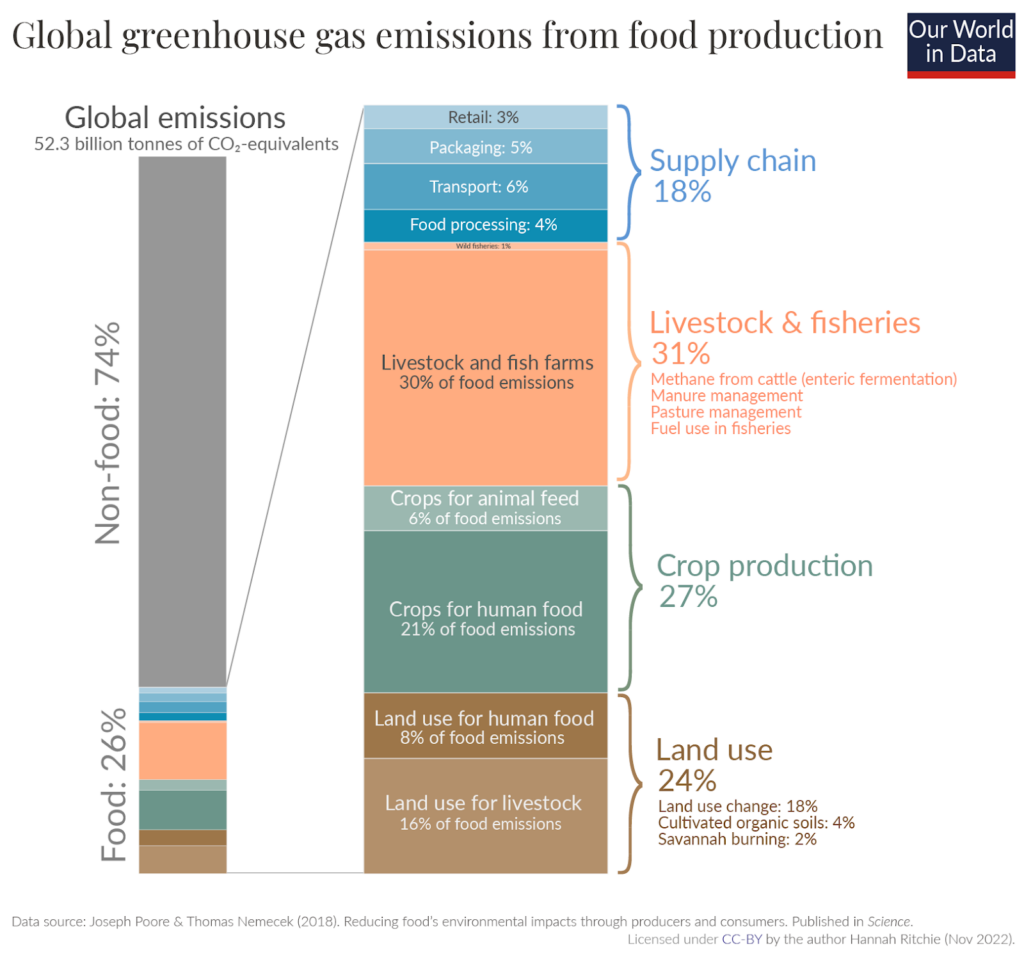
Carbon footprint is one aspect of the overall environmental impact of a fruit. It essentially measures how much carbon or other greenhouse gasses the production of strawberries emits into the atmosphere. Emissions from product manufacturing, irrigation, transportation fuel, and landfills all add up to create the overall carbon footprint of a fruit. Let’s see how the carbon footprint of peaches breaks down and contributes to their environmental impact.
How does the carbon footprint of peaches impact their environmental footprint?
- What is the overall carbon footprint of peaches: The overall carbon footprint of peaches is 0.17kg (0.38lbs) CO2e per pound of peaches. This means that for every pound of peaches produced, 0.17kg of carbon is released into the atmosphere. This is a low carbon footprint compared to other fruits.
- What are the main contributors to the carbon footprint of peaches: The main factors contributing to peaches’ carbon footprint are the long transportation distances, the amount of pesticides used, and improper waste disposal.
- Which life-cycle stage of peaches has the highest carbon footprint: The stage in peaches’ life cycle that contributes the most to their carbon footprint is transportation. Most US-consumed peaches have to come from China, which involves shipping, usually in higher-emitting refrigerated containers.
In short, though peaches’ carbon footprint is on the lower end compared to other fruits, they still create a significant amount of emissions, mainly due to transportation distances.
What Is the Waste Generation of Peaches
Peaches’ waste generation is fairly low. This is mainly because they use cardboard instead of plastic packaging, which is more recyclable. However, their composting rates are still low.
When fruit waste in the form of either packaging or organic materials, is disposed of, it can have a major impact on the environment. Whether it’s damaging wildlife, getting into oceans, emitting methane, or dissolving into microplastics that contaminate groundwater, all these materials have their part to play. In this section, we will look at how peaches’ waste affects the environment.
How does the waste generation of peaches impact their environmental footprint?
- What is the packaging of peaches: Peaches are typically packaged in cardboard boxes that have corrugated trays to fit each peach. This is likely due to their skin sensitivity, which might affect shelf life if broken. Though cardboard is one of the more environmentally-friendly types of packaging, it still contributes to deforestation. Therefore, this stage has a moderately negative impact on the environment.
- How is the packaging of peaches disposed of: Cardboard has a very high recycling rate at 89%. Therefore, the majority of peach packaging is not ending up in landfills and thus avoids many of the negative environmental consequences landfills can cause.
- How are peaches disposed of: Peaches have pits that are generally not eaten. They can theoretically be composted, but in practice, only 4% of food waste is actually composted. Furthermore, food waste is particularly harmful to the environment as it releases a greenhouse gas called methane when it is put in landfills.
In short, peaches’ use of very recyclable cardboard packaging means that their waste impact is fairly low.
What Have Been Historical Environmental Issues Connected to the Peach Industry
The peach industry has historically caused significant harm, both to waterways, as well as land loss, leading to wildlife endangerment.
All fruits have had a complex journey toward global distribution. They originate in one part of the world and often travel far to end up in your local supermarket. From farm to table, some of our favorite fruits have racked up some serious environmental damage along the way. Whether it’s deforestation to meet demand, water pollution, or disruption of wildlife, most fruits have left a path of destruction. Let’s see how peaches have fared throughout history.
What have been the key environmental issues of the peach industry?
- How much land has been lost because of peach production: Peach production takes up a total of around 400,000 hectares of land in China. China has lost a lot of natural forests to agricultural production. Due to their usage of agricultural land in China, peaches have contributed to land loss there.
- Which wildlife species have been negatively impacted or displaced because of peach production: A significant number of natural spaces in China have been destroyed to make way for agriculture, many of which are habitats for animals. Habitat loss is the leading cause of endangered species and so many species in the area have become threatened. Some endangered species in China include South China tigers, Asian elephants, and the Sumatra rhinoceros.
- Have water sources and soil been contaminated because of peach production: Peaches’ high pesticide usage means that they have contributed a significant amount to water pollution over the years. Pesticides are the leading cause of water pollution and so the damage they have caused has had a significant impact on water sources.
In short, there have been many areas over the years in which peaches have had a serious impact on the environment.
What Is the Overall Environmental Impact of Food and Agriculture
Food production in general has a high environmental impact. Everything from the amount of land used to the energy involved in irrigation to its effect on plant and animal biodiversity can be a factor in this. In the chart below, you can see how food production is one of the biggest influences on these areas of the environment.
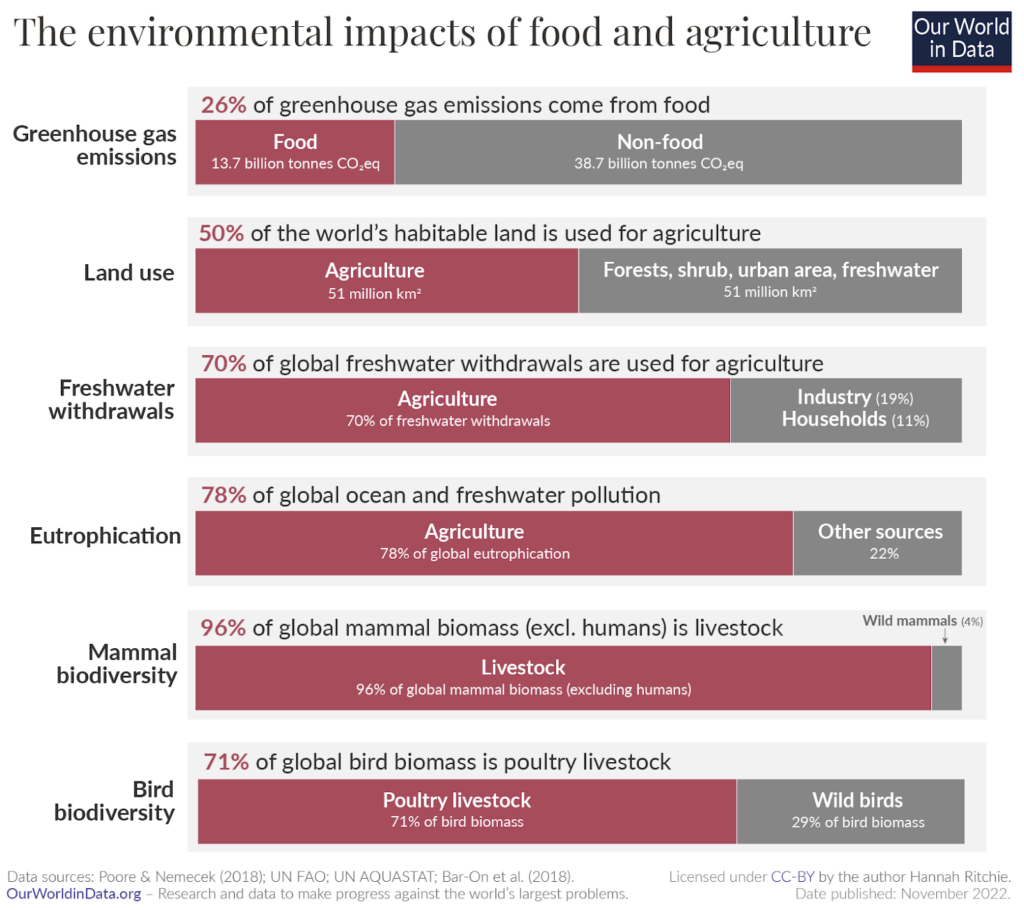
Agriculture alone accounts for over a quarter of global greenhouse gas emissions, while using half of the world’s habitable land and 70% of the global freshwater withdrawals. Agriculture also causes 78% of the global ocean and freshwater pollution.
Livestock accounts for the vast majority of non-human mammal and bird biomass. Mammal livestock outweighs wild mammals by a factor of 15-to-1, and poultry livestock outweighs wild birds by a factor of more than 3-to-1.
These statistics highlight the need for sustainable and responsible practices in food production to reduce its impact on the environment. And the need for us to shift toward more environmentally-friendly foods.
How Can You Reduce Your Environmental Impact and Offset Your Personal Carbon Footprint
There are a few things you can do to mitigate some of the negative environmental effects of consuming peaches, while still enjoying them. You can also consider offsetting your personal and peach-related carbon emissions, which work to remove carbon emissions elsewhere that are then attributed to you. Here, we will walk you through how to accomplish both of these things.
How Can You Reduce Your Environmental Impact When Shopping for Peaches
In this section, we give you a short list of ways you can reduce the negative environmental effects of oranges, based on those parts of the life-cycle of peaches that would otherwise most negatively impact the environment:
- Compost your peach pits: Peach pits often end up in landfills, which is very damaging to the environment. If you want to mitigate these effects, you should make an effort to compost your peach pits. If your city doesn’t offer a composting system, you can create your own!
- Compost packaging: Cardboard can be recycled, and often is, but recycling can actually have a negative impact on the environment. Though it is better than landfills, there are still some negative side effects of recycling that are important to be aware of. Luckily, cardboard can also be composted and so for the least impact possible, you should try to compost your cardboard peach packaging.
- Buy organic peaches: One of the biggest contributors to peaches’ environmental impact is their excessive pesticide use. Organic farms generally avoid high amounts of chemical pesticides and nitrogen fertilizers and so they are good to support if you want to reduce your pesticide and fertilizer impact.
Following some of these methods can really help you to cut down on your environmental impact of eating peaches. None of these will completely eradicate the negative impacts, since there are always effects that may be outside of your control. But some reduction is always better than nothing!
Which Organizations Can You Support to Help Alleviate Your Environmental Impact
While peaches can cause a wide range of environmental damage, there are also some organizations that help you reduce parts of your impact that would otherwise be outside of your control. These organizations are working hard to prevent and reverse damage to the environment caused by industries like peach agriculture.
In the table below are some of the best environmental charities that work in the areas where peach production has affected the environment—and beyond:
Though it is helpful to reduce the environmental impact of your personal peaches consumption, supporting these organizations takes your positive impact a step further. You will be reaching far beyond your own consumption impacts and helping to build a better world for everyone!
How Can You Offset Your Personal Carbon Footprint
The carbon footprint is a key part of your environmental impact. And it is one of the ways we measure the effects of our human-induced global climate change. Yes, even from eating peaches!
“Carbon footprint: the amount of greenhouse gasses and specifically carbon dioxide emitted by something (such as a person’s activities or a product’s manufacture and transport) during a given period”
Merriam Webster
Basically, it is the amount of carbon emitted by you as an individual or an organization providing you with goods and services—including peaches:
- This includes GHG emissions from producing the products that we use and foods that we eat (e.g., power plants, factories or farms, and landfills)
- GHG emissions from fuel that we burn directly or indirectly (e.g., logistics and transportation, cooling or heating facilities),
- as well as the GHG emissions attributed to how we consume these products and foods.
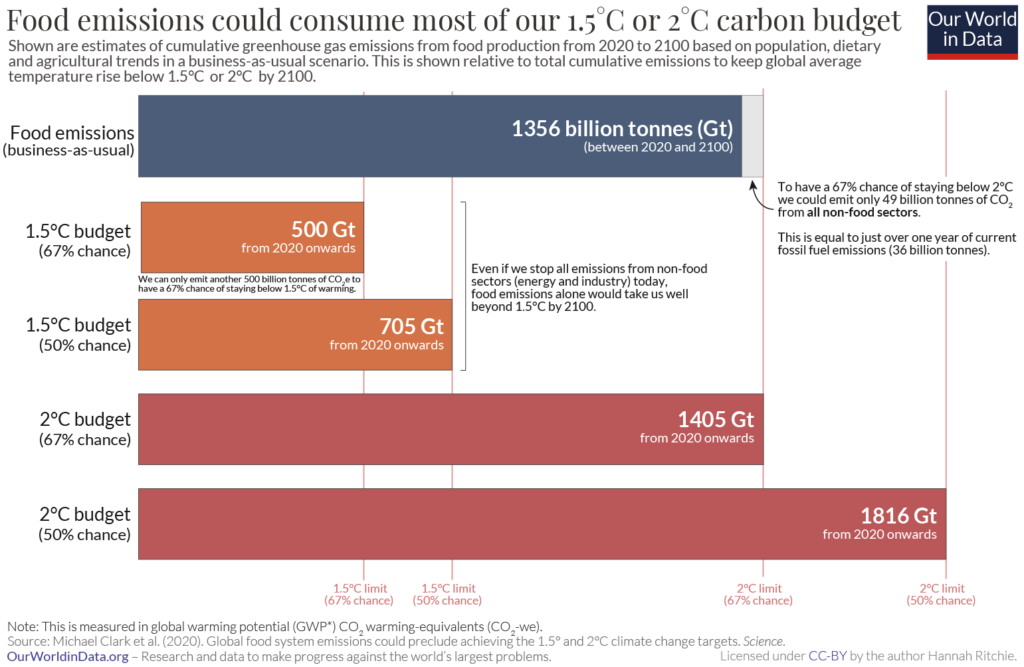
Carbon offsets are reductions in carbon emissions that are used to compensate for carbon emissions occurring elsewhere—for example for the carbon emissions that are associated with peaches. They are measured in tons of CO2 equivalents and are bought and sold through international brokers, online retailers, and trading platforms on what is known as the global carbon offset market.
“Carbon Offset: a way for a company or person to reduce the level of carbon dioxide for which they are responsible by paying money to a company that works to reduce the total amount produced in the world, for example by planting trees”
Oxford Dictionary
In terms of peaches – and indeed all food types – there will always be a carbon footprint, because of the resources it takes to get your food from farms to the place where you’ll eventually eat them. And while there are ways to reduce your carbon footprint when shopping for peaches, carbon offsets would be a way to reduce your CO2e emissions all the way down to net zero (or even to become climate positive).
However, when you purchase carbon offsets, it’s important that they actually make a difference in offsetting (aka reducing) total carbon emissions. To achieve that, the following are key criteria:
- Carbon offset projects have to be effective (different projects have different effectiveness rates)
- Carbon offset projects have to be additional
- Carbon offset projects have to be permanent
- The claims from carbon offset projects have to be verifiable
To find the best carbon offsets for you personally, check out our full guide on the best carbon offsets for individuals, where you’ll also learn more about how these carbon offset projects work, what their respective offsetting costs are, and what your best way would be to offset your own carbon emissions.
Final Thoughts
Peaches have many drawbacks when it comes to their environmental impact. A significant amount of their processes contribute to deforestation, habitat loss, and water pollution. However, there are still many things you can do to try and mitigate these damages. Buying organic peaches and making sure that you compost all waste can help to avoid some of the worst damages. You can also donate to organizations trying to solve the bigger issues!
Stay impactful,

Sources
- Statistica: Top 10 Peach-Producing US States
- Farm Flavor: 8 Fun Facts About Peaches
- UNEP: Environmental Impact Assessment
- UN: Forests, Desertification, and Biodiversity
- Our World in Data: Food Production is Responsible for One Quarter of the World’s Emissions
- WHO: Preventing Disease Through Healthy Environments
- Science Direct: Worldwide Decline of the Entomofauna
- EPA: Agriculture Sources and Solutions
- EPA: Reducing Food Waste
- FoodPrint: The Environmental Impact of Food Packaging
- NJAES: Irrigating Peaches
- Impactful Ninja: What is the Carbon Footprint of Peaches
- Our World In Data: Half of Habitable Land is Used for Agriculture
- Wiki Farmer: Peach Yield Per Hectare
- World Atlas: World’s Top Peach-Producing Countries
- Extension: Peach Production
- Science Direct: Net Primary Production and Carbon Budget
- National Grid: What is Carbon Sequestration
- Impactful Ninja: Why is a Carbon Footprint Bad for the Environment
- Clemson: Replant Site Considerations
- The Independent: Avocado, Coffee, and Citrus Fruits Threaten Global Food Security
- NCBI: Peach-Morchella Intercropping
- WWF: Soil Erosion and Degradation
- FAS: Stone Fruit Annual
- Gallant International: Environmental Impacts of Monocultures
- Impactful Ninja: What is the Carbon Footprint of Pears
- Impactful Ninja: What is the Carbon Footprint of Watermelons
- Water Footprint: What is a Water Footprint
- Global News: Pesticides on Fruits and Vegetables
- Permaculture: Pesticides and Water Pollution
- Chicago Tribune: Peaches and Pesticides
- Friends of the Earth: Effects of Pesticides on Our Wildlife
- USGS: Pesticides in Groundwater
- Direct Farm: Potassium
- Mitsui: Reducing the Environmental Effects of Chemical Fertilizers
- EPA: The Issue With Nitrogen Fertilizers
- EPA: Reducing the Impact of Wasted Food
- Frutas: Peach Packaging
- TRVST: Environmental Impact of Cardboard
- Also Known As: 12 Interesting Facts About Packaging Waste
- Colorado: Hidden Damage of Landfills
- GOV.BC: Waste Management
- We Forum: Preventing Global Deforestation
- National Geographic: Endangered Species
- Earth.org: 10 of the Most Endangered Species in China
- NRDC: Water Pollution
- Earth Easy: Composting
- Conserve Energy: Advantages and Disadvantages of Recycling
- Gardening Knowhow: Composting Cardboard
- UVM: Sources of Nitrogen for Organic Farmers
- Impactful Ninja: Best charities that fight to protect our environment
- Impactful Ninja: Best charities for reforestation
- Impactful Ninja: Best wildlife conservation charities
- Impactful Ninja: Best charities for protecting the Amazon rainforest
- Impactful Ninja: Best charities that protect our national parks
- Impactful Ninja: Best charities that fight for clean water
- Impactful Ninja: Best charities that help conserve our rivers
- Impactful Ninja: Best charities to save our oceans
- Impactful Ninja: Best charities that help farmers
- Impactful Ninja: Best charities for helping farm animals
- Impactful Ninja: Best charities for climate change
- Impactful Ninja: Best carbon offsets for individuals
- Impactful Ninja: Best charities that fight to reduce food waste
- Impactful Ninja: Best charities that fight to end plastic pollution
- Impactful Ninja: Why Is a Carbon Footprint Bad for the Environment
- Our World in Data: Environmental Impacts of Food Production
- Impactful Ninja: Best Carbon Offsets for Individuals

